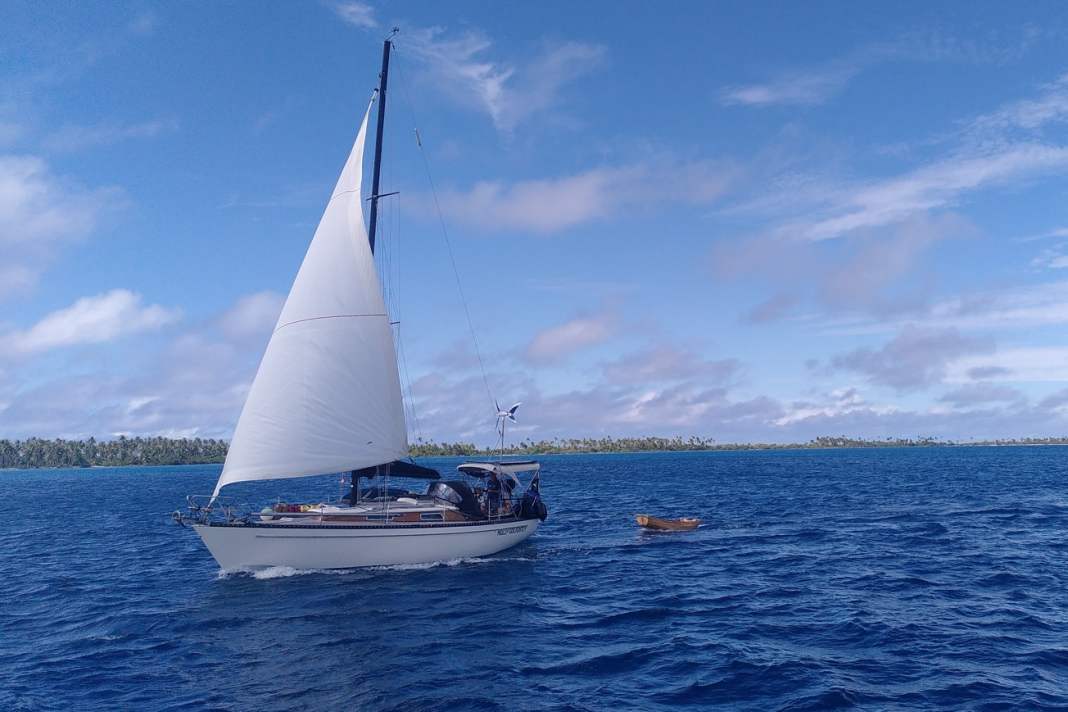





Text: Franz Schmitt
Part 1 of this cruise report can be found here!
At around one thousand square kilometres, Fakarava is also one of the largest atolls in the Tuamotus. However, the actual land area is only 16 square kilometres. It was "discovered" in 1820 by a Baltic German officer who named it Wittgenstein Island in honour of a Russian field marshal. Later, a Belgian priest came by and persuaded the inhabitants to convert to Christianity. In the north there is the small village of Rotoava, which today has 800 inhabitants.
Fakarava and the "Wall of Sharks"
Fakarava is particularly popular with divers, as the two passes are spectacular diving spots. The southern pass is known for the so-called "Wall of Sharks". As the skipper has an open-water diving licence from Curaçao, he dares to take on this challenge - but only because diving instructor Verena and Tim from the "Moana" are also on board.
For beginners, the problem here is not so much the many sharks, but the strong currents. So the gang of three book a dive in one of the local diving centres and, in addition to all kinds of exotic fish, actually get to see an impressive number of sharks snoozing in the current before setting off again in the evening to put an end to the odd colourful tropical fish. What is very sad, however, is the desolate state of the corals. Instead of bright colours, there is predominantly a bleak grey palette. Anyone who thinks climate change is a rumour should dive here! After two dives, we are both thrilled and disillusioned.
Pure South Seas: the bay of Hirifa
Two days later, we move a few miles north-east to the most beautiful corner of the atoll. Hirifa is a beautiful, gently curving bay with crystal-clear water, white sand and an infinite number of palm trees. Every South Sea cliché is catered for here. We share this beautiful spot with a few yachts from all over the world.
Beach walks, snorkelling and sundowners on the beach let the days glide by. And the small and simple restaurant on the beach also proves to be a hit. We dine here with the most exclusive view in the world. If there were no typhoons in the South Seas, you could stay here all year round.
Rotoava: Centre of the atoll
To stock up on provisions, we sail in the lagoon along the reef to the north-east corner of the island to Rotoava. The route there is well buoyed and very pleasant to sail past pearl farms, palm islands and small settlements. Rotoava has an airport, shops, petrol station, diving station and medical centre. Five nautical miles away is the north pass of the atoll, where the "Holly" skipper also books two dives together with the "Moanas", which are even more beautiful than those in the south pass.
The next day, we hire bikes and cycle along the coastal road. Outside the small centre of Rotoava, one plot of land follows another, all very spacious, lushly planted and each with a colourful house in the middle. Some offer accommodation, others sell fruit by the roadside. In the far north, we explore an old lighthouse that was still operated with a large fire at the top.
Difficult supply situation
One tricky aspect here is the supply situation. Everything that is available in the shops is delivered by a supply ship every two to three weeks. This is usually the "Aranui 5", an interesting mix of cruiser and freighter. The arrival is always a joyful event - tourists and goods are greeted with singing and music.
Unfortunately, the increasing number of blue water sailors combined with ever larger boats is becoming more and more of a problem. You can see how the dinghies drive ashore after visiting the supplier to transport everything they can get on board. As a result, the shelves are quickly empty again and the locals are very displeased. We therefore always wait one or two days to do our own shopping. In the meantime, however, the permitted number of moorings off Rotoava has been limited.
When the wind shifts unexpectedly...
At our anchorage in front of the village, we also experience what it means to be at the "wrong" end of the lagoon when the wind shifts unexpectedly. Anchormen then suddenly find themselves in an uncomfortable position: the kilometre-long fetch through the lagoon creates a short, high wave that demands everything from the anchor gear in winds of 30 knots and more. Fortunately, almost everyone stays where they belong. It's always amazing what good anchor gear can do.
After this experience, we set off again to the south of the atoll, as we want to start from there to Tahiti, which is about two days' sailing away. The sailing is fantastic, almost without waves, but with a half wind of 15 knots. We sail a small regatta with the "Moana" and the American "Forty-Two".
Farewell to Tuamotu
"Holly Golightly" gives it her all, leads the field and can't be caught. Unfortunately, our dinghy in tow has other plans. It takes on a lot of water halfway through. So we hit the emergency brake, take the dinghy sideways and scoop it empty again.
After a few more lovely days in Hirifa Bay, it's finally time to weigh anchor again and we motor through the South Pass for the last time at slack time. As soon as we are out, the sails go up and "Holly Golightly" points the bow to the south-west. Set course for Tahiti!
Part 1 of this cruise report can be found here!

